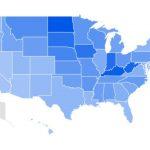
Google Trends is, without a doubt, one of the most valuable sources of open data on the internet.
It’s not a tool that’s exclusive to marketers. You’ll find many studies and research articles that were created thanks to this great resource. It was even used to identify an influenza outbreak two weeks before the CDC was able to. (We’ll get to this one in a short moment.)
So what is Google Trends?
Well, in this guide we’ll cover what Google Trends is (if you don’t know already) and we’ll get you familiar with the Google Search Trends interface and instantly find ways to implement it into your SEO and keyword research workflow.
So, let’s get into it!
A Brief History + Fun Facts
Google Trends initially launched in 2006. However, it still lets you to view data all the way back to 2004.
Google has built, shut down, and merged many different websites that used Google Search Trends data.
One of which was a “Trends for Websites” tool that allowed you to compare the search traffic of two different websites. It was kind of like the free Similar Web tool, however it made use of more concrete data. Like many cool Google products, it was unfortunately shut down.
Another was Google Flu Trends. It was a very insightful tool that did just what its name entailed – It let you view data on flu trends. It actually predicted the 2010 influenza outbreak (based on trends for common symptoms) 1 or 2 weeks before the CDC made an official announcement.
Here’s an interesting fun fact about Google Trends
From Bush/Kerry to Trump/Clinton, Google Trends has accurately predicted the victor every time since 2004.
Don’t believe me? Let’s take a look at the data:
George W. Bush vs. John Kerry

Barack Obama vs. John McCain
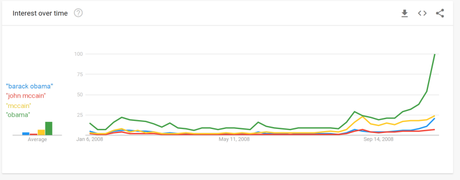
Barack Obama vs. Mitt Romney
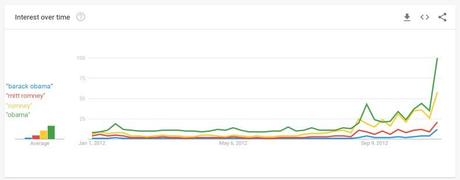
Donald Trump vs. Hillary Clinton
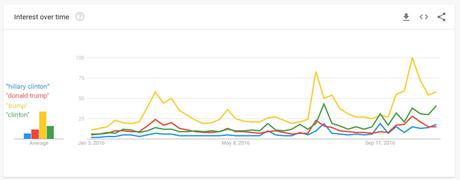
In each of these tests, I searched for both their full names as well as last names. The results are quite clear.
Will Google Trends continue to predict the outcome of US elections accurately? Only time will tell.
How To Use Google Trends
First, there’s one important thing I should tell you before you dive in.
Google Trends does not provide search volume. That would be too useful, wouldn’t it?
Instead, they give you an arbitrary scale of 0-100. “0” represents a search terms lowest point of relevance. “100” represents its highest.
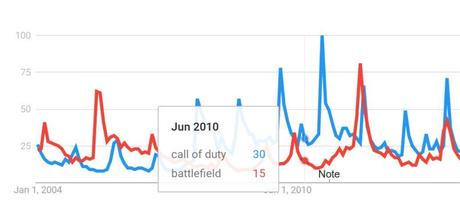
These values are entirely dynamic and change once you introduce multiple search terms. It then becomes relative to the popularity of the other search terms you provide.
By default, Google Trends makes use of data from their regular search results, but as you will learn shortly, you can also look at other sources.
Where The Data Comes From
Before we dive right in and learn how to use Google Trends, it’s important to know where the data comes from.
There are five different data sources for you to utilize.
- Web Search
- Google Image Search
- Google News
- Google Shopping
- YouTube
It is worth noting that with web search you can view data from 2004 while the other sources only allow you to go back to 2008.
You can select your desired data source by clicking the following drop-down field:

Searching For Keywords
When you’re typing a search term, you’ll see different keyword types.
In the below example, there are a variety of grouped topics to choose from.

“bernie sanders (Search term)” would only include data based around that one particular keyword.
“Bernie Sanders (United States Senator)” would include not only the main keyword but others that might be related to it. Like “senator Sanders” or “was Sanders a good senator?”
Same goes for “Bernie Sanders (Election campaign)”. It would only include data for searches around his campaign.
I’d tread carefully with these grouped keywords. Why? Just take a look at some of the “related keywords” that popped up when I was browsing the “plumbing category”. You can say I don’t have too much confidence in Google accurately grouping and associating keywords.
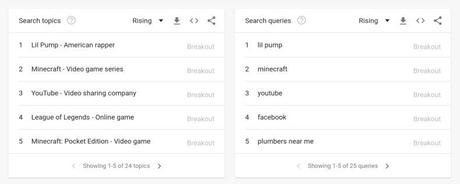
Finding General Trends
A slightly “hidden” feature of Google Search Trends is the ability to view an industry’s general trends by removing all of your current search terms. The below GIF will show you how!

It’s just passed November in America so as you can see, as soon as I removed the search terms, the biggest trends happening were related to Thanksgiving and Black Friday.
Using Search Operators = Welcomed
There are various search operators you could use to get more out of your data.
The first one is the plus operator. Simply connect as many terms as you like using plus signs to combine results. This is useful if you want to see the trend of multiple industries.
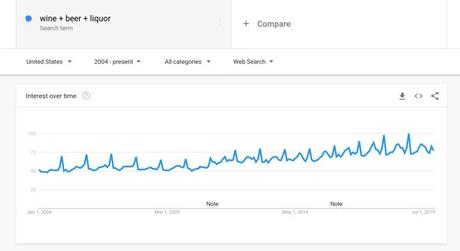
Another useful one is using double quotes in order to only include direct match results. As an example, check out the discrepancy between how to make bread and "how to make bread".
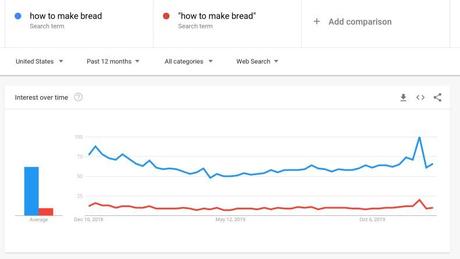
If your search term is associated with another meaning, to avoid having skewed results you can use the minus operator.
As an example, let’s say I want to get a feel for the mattress industry. However, I want to exclude people that are only looking for mattress toppers. I can do so with the following.
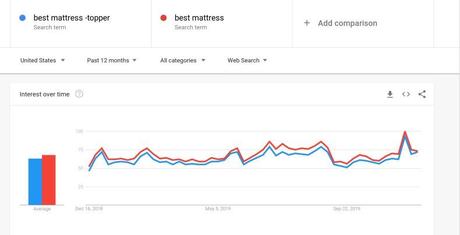
Finding Different Spellings & Abbreviations
Now that I told you about search operators, it’s time to give you a common, practical use case.
Using the plus operator, you can account for different spellings, abbreviations, and punctuation of different terms.
Take the below image as an example.

First, I set the location to “Worldwide”. After that, I started adding different variations of two terms – SEO and PPC. The goal of this trivial example was to compare the worldwide popularity of SEO and PPC.
Embedding Trends Graph to a Website
The easiest way to embed a Google Trends graph is to click the little embed button after performing a search. It’ll give you a basic code snippet to add to your website’s HTML source.
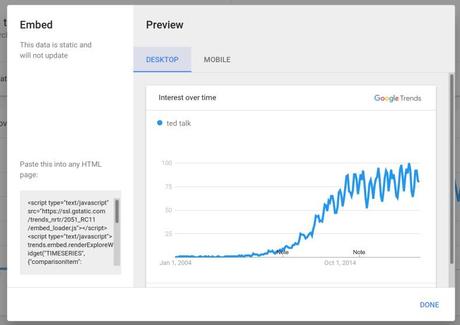
Bare in mind that Google lets you export Google Trends search data. It’ll give you a CSV. With it, you can use any sort of charting software you like to visualize your data and display it on your website.
Finding Additional Features
Often ignored by most users, Google Trends has a sidebar where you can get access to additional features.

Trending Searches
This tab operates much like trends on Twitter. In the default view, it will show you the top events in your home country. You could easily adjust the country and additionally show worldwide news if you like.
Year In Search
Google publishes reports every year on search trends. These are always interesting to take a look at. It’s a ton of fun to browse the previous “Year in Search” reports to see all of the oddball fads that were popular way back when.
Subscriptions
The most useful additional tab of Google Trends definitely has to be Subscriptions. It’s quite similar to Google Alerts. You can sign up for email alerts based on a specific topic of your choice.
Finding Hot Niches & Blog Topics
So far, we’ve covered many tricks for using Google Trends search data efficiently. Now we can actually get into some practical uses.
Ok, so I lied to you. Google Trends isn’t that great of a discovery engine for new industries. In order to identify hot niches, we’re going to need the help of an additional tool.
To find industries, you need some sort of tool that allows you to seed ideas.
You could browse through trend/hobby related websites like Trend Hunter. You could go over to the forums. You could even endlessly browse Pinterest to keep finding new hobbies/industries.
But the trend seeding tool I am going to should you is redditmetrics.com. It lets you view the fastest growing communities on reddit.
Now, most of the communities you’ll find are typical time-wasting subreddits and nothing all that serious. But then I found r/magnetfishing.
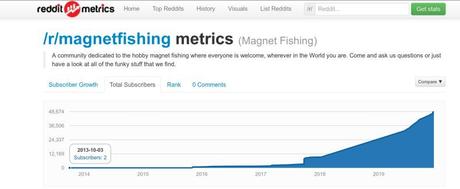
It has a large amount of growth and is an emerging hobby.
Taking a look on Google Trends reveals that it indeed is trending upwards and it still looks like it has quite a bit of room to grow!
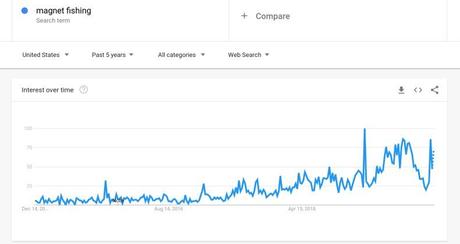
Finding Seasonal Trends
Some products sell better at different times of the year. Below is an example that you likely would have guesses yourself.
“running shoes” and “winter jackets”. Running shoe popularity peaks at the same time that popularity for winter jackets die down. And vice versa.

A less obvious example is yoga. You’d imagine it would remain constant the entire year. Well, yoga appears to be one of those “new years resolution” niches. Just like gyms, everyone gets excited for the new year, starts going to classes, and then popularity dies down. Very useful information for anyone in this sector to know.
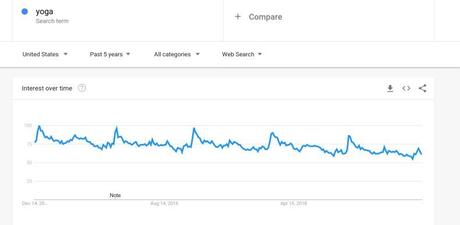
There’s a problem with search volumes in popular keyword research tools. They’re based on yearly averages!
Say a keyword gets 10 searches per month for 11 months out of the year. Then in the last month, it gets 1,000 searches.
A keyword research tool might only display an estimate of 92 searches per month. Way off!
Let’s see if we can create an estimate of how many searches a particular keyword will bring in during its hottest months.
We’ll investigate the term “Christmas stockings”. Here’s its Trends data for 2018:
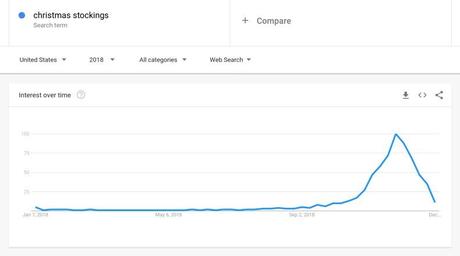
The first step is to download the data. See that little download button in the above image? Click it to get a CSV.
Now you’ll have a sheet that looks like this.
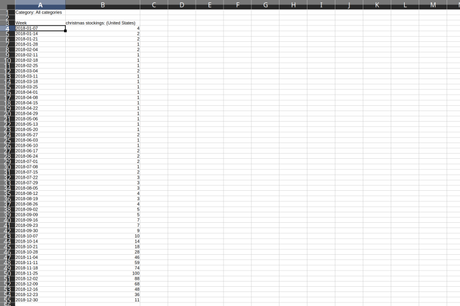
It’s organized into weeks. We need it organized into months. To do that, all that’s needed is combine some data. After a bit of number wrangling you’ll have a nice sheet like this.
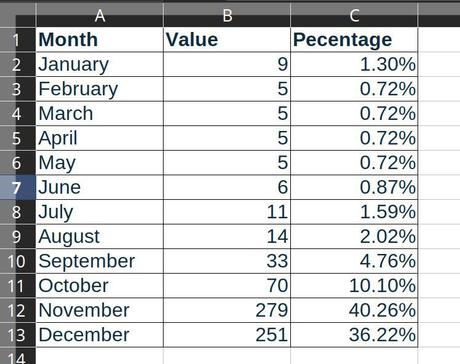
There we go! You’ll notice that I also have calculated percentages as well. This is key.
Now, we need to find the average monthly search volume. You can use any keyword research tool as you please. I choose Ahrefs.

Ahrefs shows that “Christmas stockings” gets searched 37,000 times a month.
Next, we multiple that number by 12 to get our yearly searches. 444,000.
All that’s left to do is find the monthly searches using our percentages and the yearly total, 444,000 number.
For example, we found December’s value by multiplying 444,000 with 0.3622 (36.22%).

And just like that, you’re now able to get an idea of the true monthly search volume during this search term’s peak.
160,814 is quite a difference from the initial 37,000, isn’t it?
Location-Based Keyword Trends
You want your marketing to be as effective as possible. Some areas of the country—or some areas of the world—are more interested in a product, service, or industry than others.
Take the Trends data for the traditional breakfast, grits. Most of the interest comes from south-eastern states. 
And now how about “farm equipment”. No surprise that most of the interest comes from mid-western states as well as others where farming an important industry.
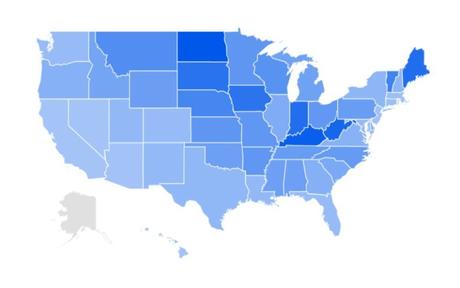
Keyword Trends For Local SEO
You can see what cities your service is most popular with a bit of location filtering.
Below, I took a look at the most popular cities around Phoenix, AZ for the term “plumbing”.
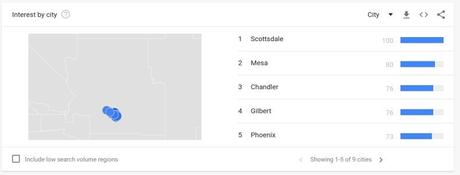
Google Trends For Olden Times
Google Trends goes back to 2004 and that’s great! However, what if we want MORE insight.
…Like insight from all the way back to the 1800s.
Well, you might think that’s impossible. No internet back then, right? That’s where books come in.
Google created a tool named Google Ngram Viewer. It’s great! Just enter one or more values and it will plot it on the chart for you.
Here’s a graph of the mentions of “brewing beer” over the last 200 or so years.
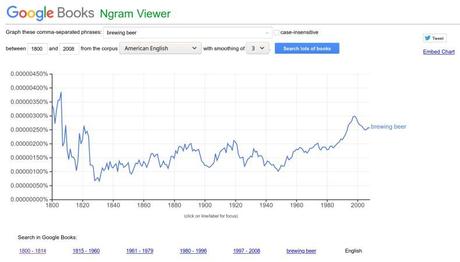
Outstanding.
It’s also a useful way to discover literature of the past. If you’re working on a research project, it’s quite useful to see how something was viewed in the past.
Final Notes + Bonus Free Training
By now, you’ve learned all the ins and outs of Google Trends as well as some ways to accomplish your SEO goals with it. It’s an excellent tool that every marketer should have at the ready.
The last tip I wanted to mention is that Google offers some great beginner level training on Google Trends. Training will uncover some of the tips mentioned in this guide such as using search operators to find keywords with different spellings and punctuation.
You can view the Google News Initiatives training here.
The post How To Use Google Trends For SEO appeared first on FATJOE.

